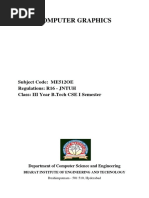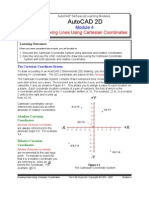Lecture1 Introduction To Computer Graphics
Uploaded by
David ArokoLecture1 Introduction To Computer Graphics
Uploaded by
David ArokoCSC 406:
Computer Graphics
Lecture1:
Introduction
January 2008 CSC 406 : Computer Graphics 2
Lecture 1:
Scope:
Introduction.
Historic overview.
Graphics hardware and software
CG components
Study question:
What is computer graphics?
State three landmark events in the development of computer
graphics.
State the components of computer graphics.
January 2008 CSC 406 : Computer Graphics 3
What is Computer Graphics:
Technically, its about the production,
manipulation and display of images using
computers
Practically, its about movies, games, art,
training, advertising, communication, design,
January 2008 CSC 406 : Computer Graphics 4
January 2008 CSC 406 : Computer Graphics 5
Historic Overview:
The development of computer graphics can
be viewed in three aspects:
Pre-historic events that are useful in this
development.
Development in Software and Algorithms.
Development in hardware, and graphics
technology.
We look at details in later lectures
January 2008 CSC 406 : Computer Graphics 6
Pre-History:- Before
graphics:
The foundations of computer graphics can be traced
to artistic and mathematical ``inventions,'' for
example,
Euclid (circa 300 - 250 BC) who's formulation of
geometry provides a basis for graphics concepts.
Filippo Brunelleschi (1377 - 1446) architect, goldsmith,
and sculptor who is noted for his use of perspective.
January 2008 CSC 406 : Computer Graphics 7
Pre-history
Rene Descarts (1596-1650) who developed analytic geometry, in
particular coordinate systems which provide a foundation for describing
the location and shape of objects in space.
Gottfried Wilhelm Leibniz (1646 - 1716) and Issac Newton (1642 - 1727)
who co-invented calculus that allow us to describe dynamical systems.
James Joseph Sylvester (1814 - 1897) who invented matrix notation. A
lot of graphics can be done with matrices.
I. Schoenberg who discovered splines, a fundamental type of curve.
J. Presper Mauchly (1919 - 1995) and John William Mauchly (1907 -
1980) who build the ENIAC computer.
January 2008 CSC 406 : Computer Graphics 8
The Early history:
The history of computer graphics can be dated back to the days of the
Whirlwind Project and the SAGE computer system, which were
designed to support military preparedness.
The Whirlwind Project started as an effort to build a flight simulator and
SAGE was to provide a air defense system in the United States to guard
against the threat of a nuclear attack.
The SAGE workstation had a vector display and light pens that operators
would use pinpoint planes flying over regions of the United States.
Besides being the age of the first vacuum tube computers, the 1940's was
when the transistor was invented at Bell Labs (1947).
In 1956, the first transistorized computer was built at MIT.
January 2008 CSC 406 : Computer Graphics 9
Hardware and Technology:
The age of Sutherlands:
In the early 1960's IBM, Sperry-Rand, Burroughs and a few
other computer companies existed.
The computers of the day had a few kilobytes of memory, no
operating systems to speak of and no graphical display
monitors.
The peripherals were punch cards, line printers, and roll-
paper plotters.
The only programming languages supported were assembler,
FORTRAN, and Algol.
Function graphs and ``Snoopy'' calendars were about the
only graphics done.
January 2008 CSC 406 : Computer Graphics 10
History Hardware
In 1963 Ivan Sutherland presented his paper
Sketchpad at the Summer Joint Computer
Conference.
Sketchpad allowed interactive design on a vector
graphics display monitor with a light pen input
device.
Most people mark this event as the origin of
computer graphics.
January 2008 CSC 406 : Computer Graphics 11
Early 70s
An Evans & Sutherland Picture System was
the high-end graphics computer.
It was a vector display with hardware support for
clipping and perspective.
Xerox PARC introduced the Altos personal
computer, and
An 8 bit computer was invented at Intel.
January 2008 CSC 406 : Computer Graphics 12
Later in the 70s
The Apple I and II computers became the first
commercial successes for personal computing.
The DEC VAX computer was the mainframe (mini)
computer of choice.
Arcade games such as Pong and Pac Mac became
popular.
Laser printers were invented at Xerox PARC.
January 2008 CSC 406 : Computer Graphics 13
The early 80s
The IBM PC was marketed in 1981 The Apple
MacIntosh started production in 1984, and
microprocessors began to take off, with the Intel
x86 chipset, but these were still toys.
Computers with a mouse, bitmapped (raster)
display, and Ethernet became the standard in
academic and science and engineering settings.
January 2008 CSC 406 : Computer Graphics 14
Later in the 80s
Sun workstations, with the Motorola 680x0 chipset became
popular as advanced workstation a in the mid 80's.
The Video Graphics Array (VGA) card was invented at
IBM.
Silicon Graphics (SGI) workstations that supported real-time
raster line drawing and later polygons became the computer
graphicists desired.
The data glove, a precursor to virtual reality, was invented at
NASA.
VLSI for special purpose graphics processors and parallel
processing became hot research areas.
January 2008 CSC 406 : Computer Graphics 15
The 90s
The computer at this time was an SGI workstation
with at least 16 MB of memory, at 24-bit raster
display with hardware support for Gouraud shading
and z-buffering for hidden surface removal.
Laser printers and single frame video recorders
were standard.
Unix, X and Silicon Graphics GL were the
operating systems, window system and application
programming interface (API) that graphicist used.
January 2008 CSC 406 : Computer Graphics 16
The 90s
Shaded raster graphics were starting to be
introduced in motion pictures.
PCs started to get decent, but still they could
not support 3-D graphics, so most
programmer's wrote software for scan
conversion (rasterization) used the painter's
algorithm for hidden surface removal, and
developed ``tricks'' for real-time animation.
January 2008 CSC 406 : Computer Graphics 17
The 90s
Hand-held computers were invented at Hewlett-Packard about 1991.
Zip drives were invented at Iomega.
The Intel 486 chipset allowed PC to get reasonable floating point
performance.
In 1994, Silicon Graphics produced the Reality Engine:
It had hardware for real-time texture mapping.
The Ninetendo 64 game console hit the market providing Reality
Engine-like graphics for the masses of games players.
Scanners were introduced.
January 2008 CSC 406 : Computer Graphics 18
Later in the 90s
PC graphics cards, for example 3dfx and Nvidia,
were introduced.
Laptops were introduced to the market.
The Pentium chipset made PCs almost as powerful
as workstations.
Motion capture, begun with the data glove,
becomes a primary method for generating
animation sequences.
January 2008 CSC 406 : Computer Graphics 19
The 90s
3-D video games become very popular: DOOM
(which uses BSP trees), Quake, Mario Brothers, etc.
Graphics effects in movies becomes pervasive:
Terminator 2, Jurassic Park, Toy Story, Titanic, Star
Wars I. Virtual reality and the Virtual Reality Meta
(Markup) Language (VRML) become hot areas for
research.
PDA's, the Palm Pilot, and flat panel displays hit
the market.
January 2008 CSC 406 : Computer Graphics 20
The 00s
Today most graphicist want an Intel PC with at least 256 MB of memory
and a 10 GB hard drive.
Their display should have graphics board that supports real-time texture
mapping.
A flatbed scanner, color laser printer, digital video camera, DVD, and
MPEG encoder/decoder are the peripherals one wants.
The environment for program development is most likely Windows and
Linux, with Direct 3D and OpenGL, but Java 3D might become more
important.
Programs are typically written in C++ or Java.
January 2008 CSC 406 : Computer Graphics 21
Software and Algorithms:
The 60s
Jack Bresenham taught us how to draw lines on a raster
device.
He later extended this to circles. Anti-aliased lines and curve
drawing is a major topic in computer graphics.
Larry Roberts pointed out the usefulness of homogeneous
coordinates, matrices and hidden line detection algorithms.
Steve Coons introduced parametric surfaces and developed
early computer aided geometric design concepts.
January 2008 CSC 406 : Computer Graphics 22
The 60s
The earlier work of Pierre Bzier on parametric
curves and surfaces also became public.
Author Appel at IBM developed hidden surface and
shadow algorithms that were pre-cursors to ray
tracing.
The fast Fourier transform was discovered by
Cooley and Tukey.
This algorithm allow us to better understand signals and
is fundamental for developing antialiasing techniques.
It is also a precursor to wavelets.
January 2008 CSC 406 : Computer Graphics 23
The 70s
Rendering (shading) were discovered by Gouraud and
Phong at the University of Utah.
Phong also introduced a reflection model that included specular
highlights.
Keyframe based animation for 3-D graphics was
demonstrated.
Xerox PARC developed a ``paint'' program.
Ed Catmull introduced parametric patch rendering, the z-
buffer algorithm, and texture mapping.
BASIC, C, and Unix were developed at Dartmouth and Bell
Labs.
January 2008 CSC 406 : Computer Graphics 24
Turned Whitted developed recursive ray
tracing and it became the standard for
photorealism.
Pascal was the programming language
everyone learned.
January 2008 CSC 406 : Computer Graphics 25
The 80s
Jim Blinn introduces blobby models and texture
mapping concepts.
Binary space partitioning (BSP) trees were
introduced as a data structure.
Loren Carpenter started exploring fractals in
computer graphics.
Postscript was developed by John Warnock and
Adobe was formed.
Steve Cook introduced stochastic sampling to ray
tracing.
January 2008 CSC 406 : Computer Graphics 26
The 80s
Radiosity was introduced by the Greenberg and folks at
Cornell.
Photoshop was marketed by Adobe.
Video arcade games took off, many people/organizations
started publishing on the desktop.
Unix and X windows were the platforms of choice with
programming in C and C++, but MS-DOS was starting to
rise.
January 2008 CSC 406 : Computer Graphics 27
The 80s
Mosaic, the first graphical Internet browser was
written by xxx at the University of Illinois, National
Center for Scientific Applications (NCSA).
MPEG standards for compressed video began to be
promulgated.
Dynamical systems (physically based modeling)
that allowed animation with collisions, gravity,
friction, and cause and effects were introduced.
January 2008 CSC 406 : Computer Graphics 28
The 80s
In 1992 OpenGL became the standard for
graphics APIs
In 1993, the World Wide Web took off.
Surface subdivision algorithms were
rediscovered.
Wavelets begin to be used in computer
graphics.
January 2008 CSC 406 : Computer Graphics 29
The 90s
Image based rendering became the area for
research in photo-realistic graphics.
Linux and open source software become
popular.
January 2008 CSC 406 : Computer Graphics 30
Future???
You should expect 3-D modeling and video
editing for the masses, computer vision for
robotic devices and capture facial
expressions, and realistic rendering of
difficult things like a human face, hair, and
water.
January 2008 CSC 406 : Computer Graphics 31
Graphics Software
Two general classifications of graphics
software:
General programming packages
Special purpose application packages
January 2008 CSC 406 : Computer Graphics 32
Graphics Software
Many application programs are
available to produce computer graphics,
either as 2D images, 3D models, or
animated sequences.
These include Corel Draw, Photoshop,
AutoCAD, Maya, SoftImage, etc.
January 2008 CSC 406 : Computer Graphics 33
Graphics Software
Several 'common' graphics
languages/libaries/APIs (Application
Programming Interfaces.)
o GKS
o DirectX
o X
o Postscript
o OpenGL
January 2008 CSC 406 : Computer Graphics 34
Why study computer graphics?
Graphics is cool
I like to see what Im doing
I like to show people what Im doing
Graphics is interesting
Involves simulation, AI, algorithms, architecture
Ill never get an Oscar for my acting
But maybe Ill get one for my CG special effects
Graphics is fun
January 2008 CSC 406 : Computer Graphics 35
Component of Computer Graphics
Modeling: Defining objects in terms of primitives, coordinates and
characteristics
Storing: storing scenes and images in memory and on disk
Manipulating: changing the shape, position and characteristics of
objects
Rendering: applying physically based procedures to generate
(photorealistic) images from scenes (using lighting and shading)
Viewing: displaying images from various viewpoints on various devices
January 2008 CSC 406 : Computer Graphics 36
Next Lecture
Graphics Hardware
You might also like
- Adobe Photoshop: Workspace Options Option Bar Menu BarNo ratings yetAdobe Photoshop: Workspace Options Option Bar Menu Bar4 pages
- EASA Fiber Optics Syllabus Revised 05162014No ratings yetEASA Fiber Optics Syllabus Revised 0516201436 pages
- Introduction To Computer-Aided Drafting Software: OVERVIEW (What Is This All About?)No ratings yetIntroduction To Computer-Aided Drafting Software: OVERVIEW (What Is This All About?)21 pages
- Intro To 3D Animation Using Blender Curriculum PDFNo ratings yetIntro To 3D Animation Using Blender Curriculum PDF7 pages
- Autocad Layering and PEN Assignment: Mary Wyn M. IchianoNo ratings yetAutocad Layering and PEN Assignment: Mary Wyn M. Ichiano17 pages
- Chapter 8 - Illumination Models & Surface-Rendering MethodsNo ratings yetChapter 8 - Illumination Models & Surface-Rendering Methods45 pages
- CS ELECT 3 - Computer Graphics and Visual ComputingNo ratings yetCS ELECT 3 - Computer Graphics and Visual Computing5 pages
- Module 1 - HCI and Interaction Design - LectureNo ratings yetModule 1 - HCI and Interaction Design - Lecture38 pages
- Networking Essentials 1206 Bac 2005230 Joy Ntinyari KimathiNo ratings yetNetworking Essentials 1206 Bac 2005230 Joy Ntinyari Kimathi5 pages
- Sub: Computer Test 4 Time: 30 Minutes Marks: 40 Name: . Batch: . Date: .No ratings yetSub: Computer Test 4 Time: 30 Minutes Marks: 40 Name: . Batch: . Date: .3 pages
- Week 003-004 Module Characteristics of Digital & Traditional GraphicsNo ratings yetWeek 003-004 Module Characteristics of Digital & Traditional Graphics2 pages
- Introduction To Computing - CS101 Power Point Slides Lecture 01.ppsNo ratings yetIntroduction To Computing - CS101 Power Point Slides Lecture 01.pps59 pages
- 00 Syllabus Multimedia Design TechnologyNo ratings yet00 Syllabus Multimedia Design Technology4 pages
- Ixs1124-Problem Solving Algorithm: C++ Fundamentals100% (1)Ixs1124-Problem Solving Algorithm: C++ Fundamentals19 pages
- Chapter 12 Solid Modeling Wireframe, Surface, Solid ModelingNo ratings yetChapter 12 Solid Modeling Wireframe, Surface, Solid Modeling11 pages
- MIT 124 Advanced Multimedia Computing SyllabusNo ratings yetMIT 124 Advanced Multimedia Computing Syllabus9 pages
- Introduction To Microsoft Excel: ComputerNo ratings yetIntroduction To Microsoft Excel: Computer6 pages
- MT830 / MT831: Energy Measurement and ManagementNo ratings yetMT830 / MT831: Energy Measurement and Management2 pages
- Chemistry Honors Final Review WorksheetNo ratings yetChemistry Honors Final Review Worksheet12 pages
- Msan-145: How To Interface Zarlink Components To Parallel Bus CpusNo ratings yetMsan-145: How To Interface Zarlink Components To Parallel Bus Cpus20 pages
- Flexkraft Air-Cooled Rectifiers: Single & Dual Outputs With Optional Polarity ReversalNo ratings yetFlexkraft Air-Cooled Rectifiers: Single & Dual Outputs With Optional Polarity Reversal2 pages
- Installation Detail Drawing For Pipeline Cathodic Protection SystemNo ratings yetInstallation Detail Drawing For Pipeline Cathodic Protection System29 pages
- RRU3953&RRU3953w Description: Huawei Technologies Co., LTDNo ratings yetRRU3953&RRU3953w Description: Huawei Technologies Co., LTD27 pages
- Binalonan Water District: Website Design and Development ProposalNo ratings yetBinalonan Water District: Website Design and Development Proposal15 pages
- How To Create A Microblaze AXI4 DDR3 Embedded System and Stay AliveNo ratings yetHow To Create A Microblaze AXI4 DDR3 Embedded System and Stay Alive12 pages
- PPM 300 Designer S Handbook 4189340911 UkNo ratings yetPPM 300 Designer S Handbook 4189340911 Uk535 pages
- Adobe Photoshop: Workspace Options Option Bar Menu BarAdobe Photoshop: Workspace Options Option Bar Menu Bar
- Introduction To Computer-Aided Drafting Software: OVERVIEW (What Is This All About?)Introduction To Computer-Aided Drafting Software: OVERVIEW (What Is This All About?)
- Intro To 3D Animation Using Blender Curriculum PDFIntro To 3D Animation Using Blender Curriculum PDF
- Autocad Layering and PEN Assignment: Mary Wyn M. IchianoAutocad Layering and PEN Assignment: Mary Wyn M. Ichiano
- Chapter 8 - Illumination Models & Surface-Rendering MethodsChapter 8 - Illumination Models & Surface-Rendering Methods
- CS ELECT 3 - Computer Graphics and Visual ComputingCS ELECT 3 - Computer Graphics and Visual Computing
- Networking Essentials 1206 Bac 2005230 Joy Ntinyari KimathiNetworking Essentials 1206 Bac 2005230 Joy Ntinyari Kimathi
- Sub: Computer Test 4 Time: 30 Minutes Marks: 40 Name: . Batch: . Date: .Sub: Computer Test 4 Time: 30 Minutes Marks: 40 Name: . Batch: . Date: .
- Week 003-004 Module Characteristics of Digital & Traditional GraphicsWeek 003-004 Module Characteristics of Digital & Traditional Graphics
- Introduction To Computing - CS101 Power Point Slides Lecture 01.ppsIntroduction To Computing - CS101 Power Point Slides Lecture 01.pps
- Ixs1124-Problem Solving Algorithm: C++ FundamentalsIxs1124-Problem Solving Algorithm: C++ Fundamentals
- Chapter 12 Solid Modeling Wireframe, Surface, Solid ModelingChapter 12 Solid Modeling Wireframe, Surface, Solid Modeling
- Msan-145: How To Interface Zarlink Components To Parallel Bus CpusMsan-145: How To Interface Zarlink Components To Parallel Bus Cpus
- Flexkraft Air-Cooled Rectifiers: Single & Dual Outputs With Optional Polarity ReversalFlexkraft Air-Cooled Rectifiers: Single & Dual Outputs With Optional Polarity Reversal
- Installation Detail Drawing For Pipeline Cathodic Protection SystemInstallation Detail Drawing For Pipeline Cathodic Protection System
- RRU3953&RRU3953w Description: Huawei Technologies Co., LTDRRU3953&RRU3953w Description: Huawei Technologies Co., LTD
- Binalonan Water District: Website Design and Development ProposalBinalonan Water District: Website Design and Development Proposal
- How To Create A Microblaze AXI4 DDR3 Embedded System and Stay AliveHow To Create A Microblaze AXI4 DDR3 Embedded System and Stay Alive
























































































